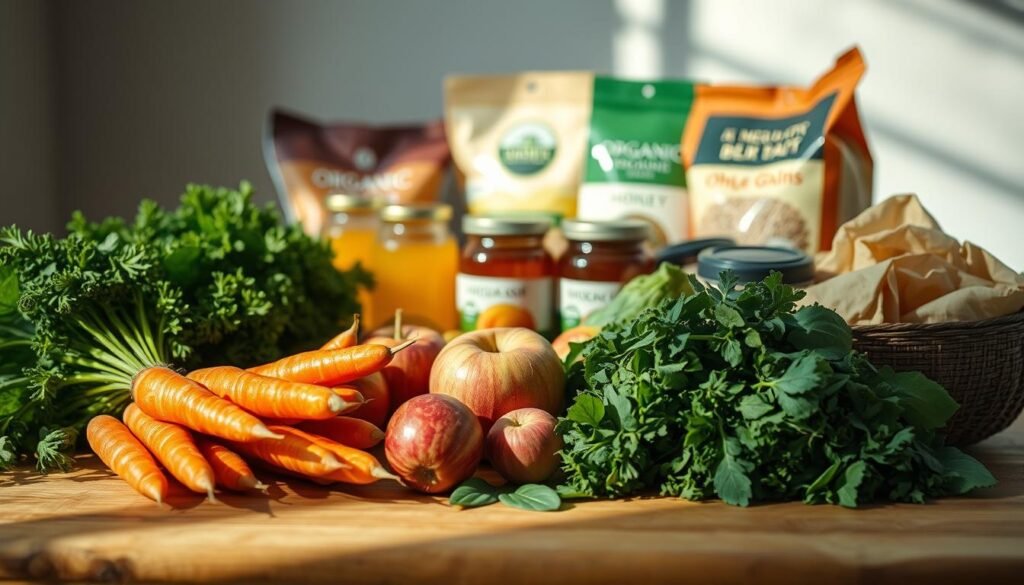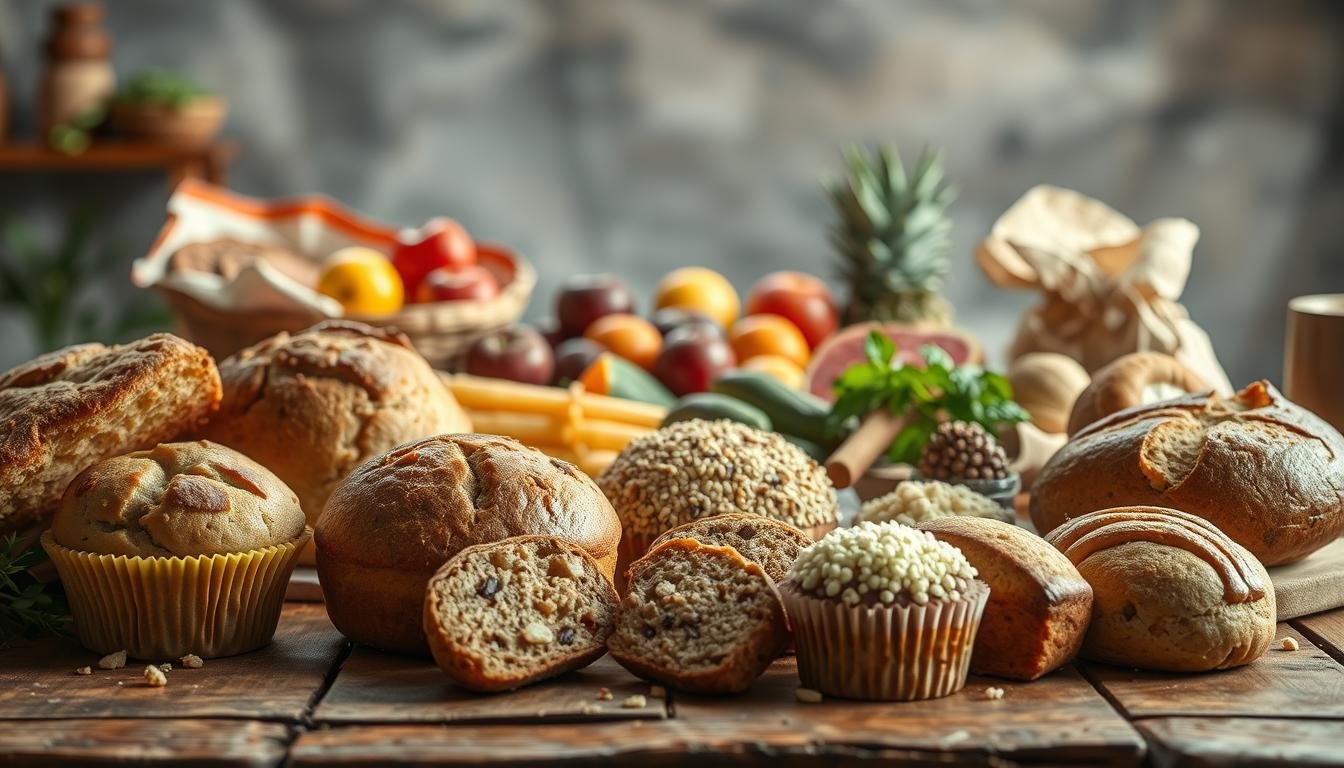Did you know not all “natural” ingredients are organic? Shelves are full of labels like “clean” and “organic.” But how do you know what’s good for you and the planet?
Key Takeaways
- Organic ingredients are grown without synthetic pesticides or GMOs, prioritizing sustainability.
- Natural ingredients may contain additives, unlike certified organic products.
- Clean ingredients align with rising consumer demand for transparency and safety.
- USDA Organic certification ensures strict farming and processing standards.
- Choosing organic supports eco-friendly practices and reduces chemical exposure.
Today’s consumers want food they can trust. Organic ingredients are a choice supported by science and rules. From farms to kitchens, knowing these basics helps make sense of labels and trends.
Certified organic products meet strict rules to protect people and the planet. But myths about cost or effectiveness confuse shoppers. This guide clears up the confusion, showing how organic ingredients play a key role in our diets.
Understanding Organic Ingredients
Choosing organic ingredients means knowing what the term really means. This section will explain certifications, standards, and why these choices are good for health and the planet.
What Does “Organic” Mean?
Organic ingredients are made without synthetic chemicals, GMOs, or artificial additives. Natural ingredients follow strict farming practices. These practices focus on soil health and ecological balance.
- No synthetic pesticides or fertilizers
- No genetically modified organisms (GMOs)
- No artificial colors or preservatives
The Benefits of Choosing Organic
Choosing chemical-free ingredients lowers exposure to harmful residues. It also helps the environment by keeping water clean and protecting biodiversity.
Certification and Regulations
“USDA-certified organic products undergo annual inspections to ensure compliance with federal standards.” – USDA Agricultural Marketing Service
| Certification | Key Standards | Examples |
|---|---|---|
| USDA Organic | 100% synthetic-free production | Produce, dairy, packaged foods |
| Non-GMO Project Verified | Guarantees no GMO content | Snacks, grains |
| Certified Naturally Grown | Local farm-based certification | Farmers’ market goods |
Look for the USDA Organic logo to check if it’s real. These certifications make sure organic ingredients meet strict rules.
The Importance of Organic Farming
Organic farming is more than just growing food. It changes how we produce food to protect our planet and communities. By not using synthetic chemicals, it makes our environments healthier and helps local economies grow.
Environmental Impact
Organic farming focuses on using sustainable ingredients. It keeps soil healthy with natural methods like composting. This helps prevent soil erosion and captures more carbon.
Studies show organic fields hold 20% more water, helping them stay resilient during droughts. Using eco-friendly ingredients also reduces harmful pesticide runoff, protecting nearby water sources.
- Reduces soil degradation by 30% compared to conventional methods
- Encourages biodiversity through crop rotation and natural pest control
- Cuts greenhouse gas emissions by minimizing synthetic fertilizer use
Supporting Local Farmers
Choosing organic ingredients helps communities. Local farmers, like California’s Full Belly Farm, can grow without corporate pesticides. They can then invest in their local economies.
A USDA report shows organic farms hire 25% more local workers. This leads to fair wages and job stability.
| Aspect | Conventional Farming | Organic Farming |
|---|---|---|
| Chemical Use | Heavy pesticides | Natural solutions |
| Local Economy | National/Global supply chains | Supports regional businesses |
| Worker Safety | Exposure to toxins | Safer working conditions |
Choosing eco-friendly ingredients is more than a choice. It’s a promise to protect our planet and the people who grow our food.
Common Organic Ingredients in Your Pantry
Starting a pantry with organic ingredients is easy. It begins with everyday items. These ingredients are good for you and the planet. Here’s a list of must-haves for a healthier kitchen.
Organic Grains and Cereals
Whole grains like oats, quinoa, and brown rice are key. Brands like Bob’s Red Mill and Nature’s Path have organic options. Make sure they’re certified to avoid GMOs and pesticides.
Use them in breakfast bowls, salads, or homemade treats.
Organic Fruits and Vegetables
Fruits like berries and leafy greens often have more pesticides. Choose organic versions of the Environmental Working Group’s “Dirty Dozen” list. This includes apples and spinach.
Stock up on frozen organic produce for all seasons. Brands like Earthbound Farm offer affordable, certified options.
Organic Dairy Products
Certified organic dairy avoids synthetic hormones and antibiotics. Brands like Organic Valley and Stonyfield have milk, yogurt, and cheese. They cost about the same as non-organic.
Choosing these ingredients means less exposure to additives. You still get great taste and nutrition.
Start by swapping one item at a time. Look for USDA Organic seals and try store brands for savings. Every change helps your health and the planet.
How to Identify Organic Products
Choosing organic ingredients means knowing what to look for. Here’s how to spot authentic products and avoid misleading claims.

Reading Labels
Check product labels carefully. Look for terms like certified organic or non-toxic ingredients. Avoid items labeled “natural” without certification:
- 100% Organic: Contains only organic ingredients
- Organic: At least 95% organic ingredients
- Made With Organic: Contains 70% organic ingredients
Products using “clean ingredients” must list non-GMO and pesticide-free components. Avoid items with vague terms like “all-natural” without certification.
Recognizing Certifications
Look for official seals from trusted organizations. Compare certifications:
| Certification | Key Standards |
|---|---|
| USDA Organic | Bans synthetic pesticides, GMOs |
| Oregon Tilth | Meets USDA criteria plus local farming practices |
| Certified Naturally Grown | Small-farm focused, transparent supply chains |
| Non-GMO Project | Verifies absence of genetically modified organisms |
Always verify logos match official seals. For example, the USDA Organic seal features a circular logo with “USDA Certified.”
“Certified organic products undergo annual inspections to maintain standards.” — USDA Agricultural Marketing Service
Steer clear of “greenwashing” tactics. If a product lacks certification but claims to use non-toxic ingredients, contact the brand for proof of sourcing.
The Health Benefits of Organic Ingredients
Organic ingredients are good for our health. Studies show they boost nutrition and cut down on harmful chemicals. This fits with the trend of choosing healthier foods.
Nutritional Advantages
Research finds organic foods have more nutrients. A 2012 study in the Journal of Agricultural and Food Chemistry showed organic crops have 20–40% more antioxidants. These help fight cell damage and chronic diseases.
- Higher vitamin C and mineral content in organic fruits and vegetables.
- Lower heavy metal exposure due to non-toxic ingredients in farming practices.
- Antioxidant levels up to 60% higher in some organic produce, per USDA data.
Reducing Chemical Exposure
“Pesticide residues in non-organic foods pose risks, especially for children and pregnant individuals,” states the Environmental Working Group (EWG).
Chemical-free ingredients mean no synthetic pesticides like glyphosate. These chemicals can harm our brains and development. Pregnant women and babies are especially at risk.
Choosing organic also means less growth hormones and antibiotics in meat. Organic dairy and grains avoid additives that can mess with our metabolism.
Organic Ingredients vs. Conventional Ingredients
Choosing between organic and conventional ingredients is a big decision. It involves thinking about health, taste, and how they affect the environment. Here’s a comparison:
Key Differences
- Production methods: Organic ingredients avoid synthetic pesticides and GMOs. They use sustainable ingredients and natural fertilizers.
- Environmental impact: Conventional farming can harm soil and water. Organic practices help biodiversity and cut pollution.
- Additives: Organic items don’t have artificial preservatives. They use natural ingredients to stay fresh.
Flavor and Quality Comparison
“Organic vegetables have a deeper, more complex flavor because they grow slower without chemical boosts.” – Chef Maria Gonzalez, farm-to-table advocate
Many chefs say organic ingredients taste better and last longer. This is because they grow in richer soil. While conventional foods might look the same, organic foods often have more variety and quality.
Organic ingredients also have a different shelf life. They might spoil faster without additives. But, with the right storage, they can last longer. Brands like Thrive Market show this balance, offering organic staples with clear labels.
Cooking with Organic Ingredients
Make your kitchen a place of freshness with organic ingredients. Start with small changes and enjoy the benefits. Here’s how to add organic options to your daily meals.
Tips for Incorporating Organics
- Seasonal shopping: Save money by picking plant-based ingredients when they’re in season. Or choose frozen options for all year.
- Prioritize high-risk items: Focus on produce like berries or leafy greens. Organic reduces pesticide exposure here.
- Experiment with techniques: Adjust cooking times for clean ingredients. Some may need less seasoning to show off their natural taste.
Recipes Featuring Organic Ingredients
Try these easy dishes that highlight organic quality:
- Quinoa Salad Bowl: Mix roasted veggies, organic chickpeas, and a lemon-tahini dressing. Swap with conventional legumes if needed.
- Herb-Roasted Chicken: Use organic poultry and aromatic herbs. Let natural flavors shine.
- Smoothie Boost: Blend spinach, organic bananas, and almond milk. It’s a nutrient-packed breakfast.
Small changes make a big difference. Whether baking, grilling, or snacking, organic choices improve taste and health step by step.
The Rise of Organic Products in the Market

More and more people want organic ingredients. In 2022, U.S. organic food sales hit $62 billion, up 12% from the year before. This shows how important eco-friendly ingredients are for health and the planet.
Consumer Demand Trends
- Health-conscious shoppers look for organic to avoid harmful chemicals and artificial stuff.
- People care about the environment and want organic to help reduce harm from farming.
- Younger buyers want to know the truth about what they buy. They choose brands that are open about being green.
Major Organic Brands to Know
| Brand | Key Products | Sustainability Focus |
|---|---|---|
| Bob’s Red Mill | Organic grains, flours | Carbon-neutral facilities |
| Clif Bar | Organic snacks, energy bars | 100% renewable energy use |
| Evergreen Farm | Natural ingredients, juices | Zero-waste packaging initiatives |
“Organic products are no longer a niche market—they’re reshaping how Americans eat,” said a 2023 USDA report.
Big names like Walmart and Target are now big on organic. This shows organic is becoming mainstream. Companies like Just Mayo (owned by Unilever) show you can make natural products big without losing quality. As more people want eco-friendly stuff, brands that care about the planet are winning over customers.
Debunking Myths About Organic Ingredients
Organic ingredients often face skepticism due to myths. These myths misrepresent their value. Let’s clear up the facts behind these common misunderstandings.
Common Misconceptions
“Organic is just a buzzword for higher prices.” – A common myth needing correction
- Myth 1: Organic is a marketing gimmick. Scientific studies show organic farming avoids synthetic pesticides. This offers health and environmental benefits.
- Myth 2: No taste difference exists. Many chefs prefer organic for its richer flavors. These flavors come from soil health and natural growing practices.
- Myth 3: Organic is always too expensive. Prices can vary. But, long-term health and environmental savings can offset the upfront costs.
The Reality of Organic Pricing
Higher costs come from several factors:
| Factor | Organic Ingredients | Conventional Ingredients |
|---|---|---|
| Labor Costs | Higher wages and manual labor | Mechanized, lower labor investment |
| Certification Fees | Mandatory USDA certification costs | No certification required |
| Environmental Costs | Factor in soil health and water conservation | Externalizes environmental damage costs |
Looking at prices alone misses hidden costs. These include healthcare expenses from pesticide exposure or water pollution cleanup. Sustainable ingredients and plant-based options often match organic practices. They offer long-term value.
Future Trends in Organic Food Industry
More people are learning about organic ingredients. This is changing how we make and eat these products. New ideas and changing tastes are leading the way.
Innovations on the Horizon
New farming tech is making organic farming better. Companies are using precision agriculture to cut down on waste. They’re also exploring lab-grown foods and plant-based options.
Startups like Just and Beyond Meat are leading the charge. They’re making foods without chemicals using green methods. There’s also hope for safer farming with natural pest control.
Predictions for Organic Consumption
Experts say organic food will become more popular. By 2030, sales could reach $80 billion in the U.S. This growth is thanks to urban farming and delivery services.
Big stores like Walmart and Target are now selling organic products. This makes organic food easier to find. Laws might get stricter too, to prevent false claims about green products.



